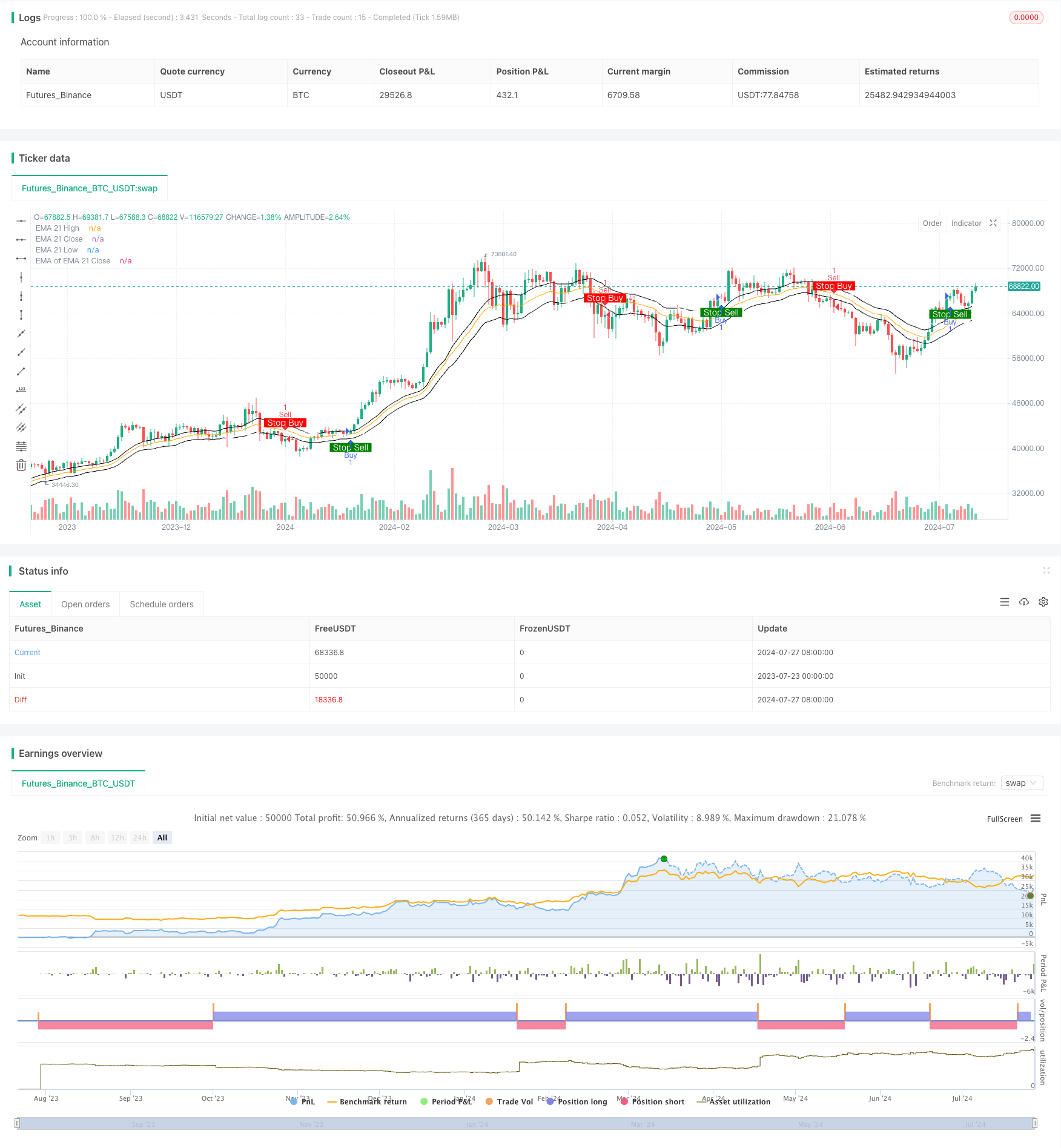
Overview
The Multi-EMA Crossover Stop Strategy is a quantitative trading approach that utilizes multiple Exponential Moving Averages (EMAs) to generate buy and sell signals. This strategy applies 21-period EMAs to different price data (high, close, and low) and a second-smoothed EMA of the 21-period close EMA. The core idea is to capture market trend changes and issue stop buy or stop sell signals when trends reverse, helping traders adjust their positions timely.
Strategy Principles
Calculate four EMA lines:
- 21-period EMA of high prices
- 21-period EMA of close prices
- 21-period EMA of low prices
- 21-period EMA of the 21-period close EMA (double-smoothed)
Signal Generation:
- Buy signal: When the 21-period close EMA crosses above the double-smoothed EMA
- Sell signal: When the 21-period close EMA crosses below the double-smoothed EMA
Trade Execution:
- Enter long position on buy signals
- Enter short position on sell signals
Visualization:
- Plot all EMA lines on the chart
- Display buy signals as upward arrows labeled “Stop Sell”
- Display sell signals as downward arrows labeled “Stop Buy”
Strategy Advantages
Multiple Confirmations: By using multiple EMA lines, the strategy confirms market trends from different angles, reducing false signals.
Trend Following: The characteristics of EMAs allow the strategy to effectively capture medium to long-term trends, suitable for trend-following trading.
Flexibility: The strategy allows users to customize various parameters, including EMA periods and colors, adaptable to different markets and personal preferences.
Visual Intuitiveness: By visually displaying multiple EMA lines and trading signals on the chart, traders can more easily understand market dynamics.
Risk Management: The use of “Stop Buy” and “Stop Sell” concepts reminds traders to stop trading in the respective direction when trends may reverse, helping to control risk.
Automation: The strategy can be easily automated, reducing emotional interference in trading decisions.
Strategy Risks
Lag: As lagging indicators, EMAs may not react quickly enough in fast-changing markets, leading to delayed entries or exits.
Ineffective in Ranging Markets: In sideways, choppy markets, the strategy may generate frequent false signals, increasing trading costs.
Parameter Sensitivity: Different EMA parameter settings can lead to entirely different results, requiring careful optimization and backtesting.
Lack of Stop-Loss Mechanism: The strategy itself doesn’t have a clear stop-loss mechanism, potentially leading to significant losses in sudden trend reversals.
Over-reliance on Technical Indicators: Ignoring fundamental and other market factors may result in missed important trading opportunities or falling into traps.
Strategy Optimization Directions
Introduce Additional Filters: Consider combining other technical indicators (e.g., RSI, MACD) or price action patterns to reduce false signals.
Dynamic Parameter Adjustment: Implement dynamic adjustment of EMA periods to adapt to different market volatility conditions.
Add Stop-Loss and Take-Profit Mechanisms: Set stop-loss and take-profit points based on ATR or fixed percentages to better control risk and lock in profits.
Optimize Entry Timing: Consider waiting for pullbacks or confirmations after signals appear to get better entry prices.
Incorporate Volume Analysis: Combine volume indicators to improve signal reliability.
Implement Adaptivity: Automatically adjust strategy parameters or switch trading logic based on market states (trending/ranging).
Integrate Multi-Timeframe Analysis: Consider trend confirmation on higher timeframes to reduce counter-trend trades.
Conclusion
The Multi-EMA Crossover Stop Strategy is a powerful and flexible trend-following system that captures market directions through the crossovers of multiple EMA lines. Its main advantages lie in providing clear visual signals and automated trading capabilities while offering high customizability. However, the strategy also faces challenges such as lag and poor performance in ranging markets.
To further improve the strategy’s effectiveness, traders can consider introducing additional filtering mechanisms, optimizing parameter settings, and combining other technical and fundamental analysis methods. Additionally, incorporating appropriate risk management measures, such as stop-loss and take-profit mechanisms, is crucial for the strategy’s long-term success.
Overall, this strategy provides traders with a solid foundation framework that can be customized and optimized according to individual trading styles and market characteristics. Through continuous backtesting and live trading validation, traders can gradually refine the strategy, improving its adaptability and profitability across different market environments.
/*backtest
start: 2023-07-23 00:00:00
end: 2024-07-28 00:00:00
period: 1d
basePeriod: 1h
exchanges: [{"eid":"Futures_Binance","currency":"BTC_USDT"}]
*/
//@version=5
strategy("Stop Buy/Sell", overlay=true)
// Input settings for the EMAs
show_ema21_high = input(true, title="Show EMA 21 High")
ema21_high_color = input.color(color.black, title="Color for EMA 21 High")
ema21_high_length = input.int(21, title="Length for EMA 21 High")
show_ema21_close = input(true, title="Show EMA 21 Close")
ema21_close_color = input.color(color.orange, title="Color for EMA 21 Close")
ema21_close_length = input.int(21, title="Length for EMA 21 Close")
show_ema21_low = input(true, title="Show EMA 21 Low")
ema21_low_color = input.color(color.black, title="Color for EMA 21 Low")
ema21_low_length = input.int(21, title="Length for EMA 21 Low")
show_ema_ema21_close = input(true, title="Show EMA of EMA 21 Close")
ema_ema21_close_color = input.color(color.white, title="Color for EMA of EMA 21 Close")
ema_ema21_close_length = input.int(21, title="Length for EMA of EMA 21 Close")
// Input settings for buy/sell signals
show_buy_signal = input(true, title="Show Buy Signal")
buy_signal_color = input.color(color.green, title="Color for Buy Signal")
buy_signal_font_color = input.color(color.white, title="Font Color for Buy Signal")
show_sell_signal = input(true, title="Show Sell Signal")
sell_signal_color = input.color(color.red, title="Color for Sell Signal")
sell_signal_font_color = input.color(color.white, title="Font Color for Sell Signal")
// Calculating the EMAs
ema21_high = ta.ema(high, ema21_high_length)
ema21_close = ta.ema(close, ema21_close_length)
ema21_low = ta.ema(low, ema21_low_length)
ema_ema21_close = ta.ema(ema21_close, ema_ema21_close_length)
// Plotting the EMAs with conditional visibility
plot(show_ema21_high ? ema21_high : na, color=ema21_high_color, linewidth=1, title="EMA 21 High")
plot(show_ema21_close ? ema21_close : na, color=ema21_close_color, linewidth=1, title="EMA 21 Close")
plot(show_ema21_low ? ema21_low : na, color=ema21_low_color, linewidth=1, title="EMA 21 Low")
plot(show_ema_ema21_close ? ema_ema21_close : na, color=ema_ema21_close_color, linewidth=1, title="EMA of EMA 21 Close")
// Generating buy and sell signals based on the crossover of EMA 21 Close and EMA of EMA 21 Close
buySignal = ta.crossover(ema21_close, ema_ema21_close)
sellSignal = ta.crossunder(ema21_close, ema_ema21_close)
// Plot buy and sell signals on the chart if enabled
plotshape(series=buySignal and show_buy_signal ? buySignal : na, location=location.belowbar, color=buy_signal_color, textcolor=buy_signal_font_color, style=shape.labelup, text="Stop Sell", size=size.small)
plotshape(series=sellSignal and show_sell_signal ? sellSignal : na, location=location.abovebar, color=sell_signal_color, textcolor=sell_signal_font_color, style=shape.labeldown, text="Stop Buy", size=size.small)
// Trading strategy logic
if (buySignal)
strategy.entry("Buy", strategy.long)
if (sellSignal)
strategy.entry("Sell", strategy.short)